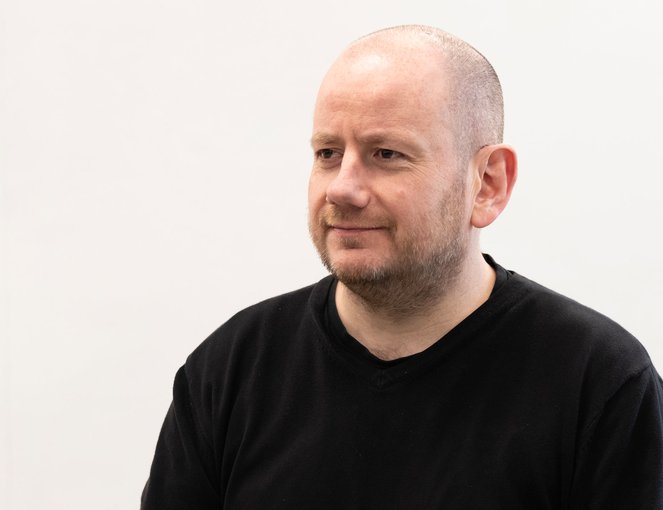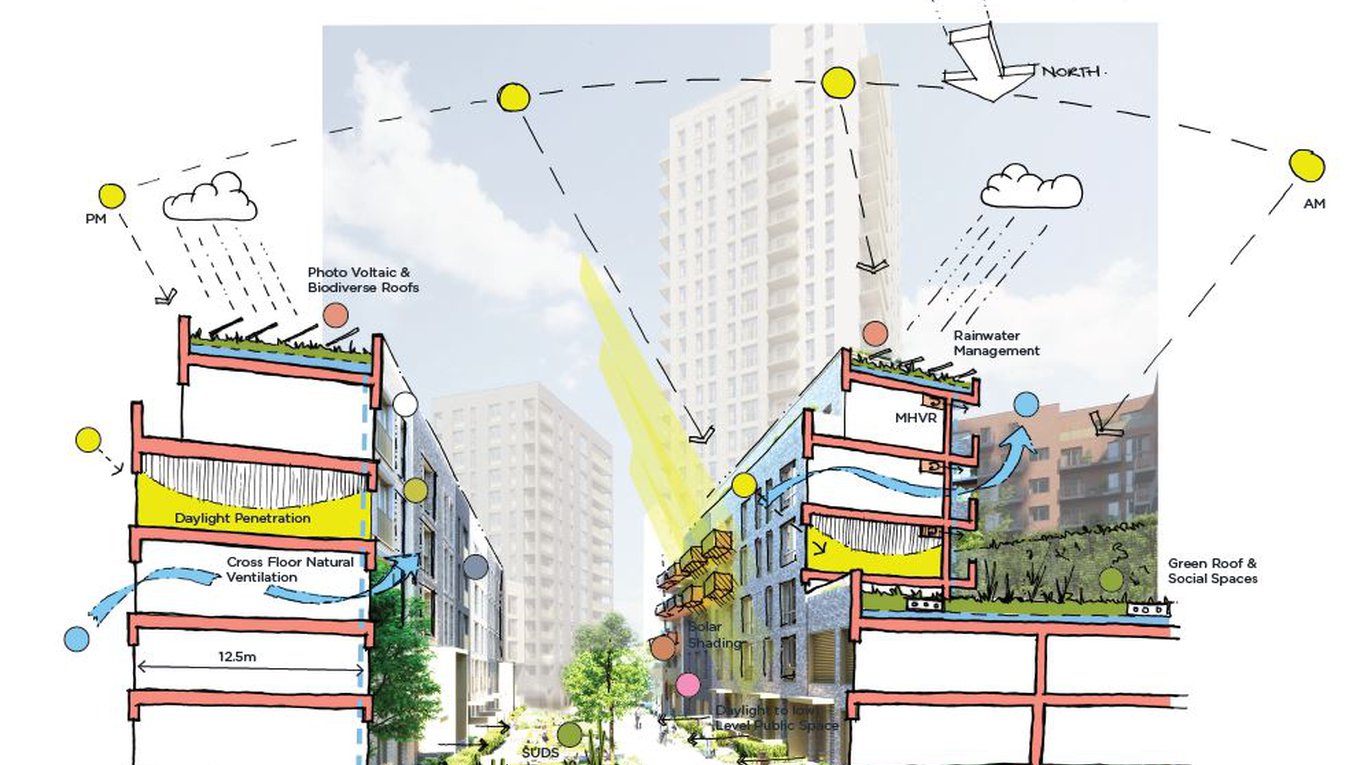
06/10/2020 • What we believe
“What we do matters”: discussing sustainability with Mike Valmas
It’s been a challenging year for the construction industry. But for Mike Valmas, Mount Anvil’s Head of Pre-Construction, Energy & Sustainability, 2020 has also offered the industry some real opportunities – including the chance to take stock, to develop and roll out new ways of working, and to look to a more sustainable future.
That sustainable future has been at the heart of how we work for years. Our focus on design excellence and creating the highest possible quality end product – as well as our core values of working collaboratively, raising the bar and doing the right thing – are all rooted in sustainability.
So, we caught up with Mike to talk about new opportunities, new ways of building, and what the future looks like for sustainability at Mount Anvil.

Hi Mike! Following the COVID-19 shutdowns there’s a lot of talk about ‘building back better’ – what does that idea mean to you?
It’s been a strange year! I think now we’re able to look at the situation more objectively we can see some of the opportunities that the crisis has presented. The whole industry has been forced to find new ways of doing things, better collective approaches from office functions to site teams, right across the lifecycle of a build.
One of the clearest messages to come out of the pandemic has been around sustainability. We know we’re in the midst of a climate crisis, and that we’ve got a narrow window of time to turn things around. The global shutdown has really shown that, with new behaviours and approaches, we’re still able to positively impact the environment, from improving air quality to creating better conditions for biodiverse flora and fauna.
So, we have an opportunity to make a difference – what we do matters. We have a chance to create outstanding places that are significantly better than what came before them, and we should be grabbing that opportunity with both hands. That’s what ‘building back better’ means to me.
Amazing. So, how do you think developers could begin to prioritise sustainable development?
This is a huge question… For me, it starts with ensuring that sustainability is considered right through the development process. It needs to be fundamental to project briefs, to be built into design processes, tendering, construction, operation – even the use of the development once it’s complete.
That’s a journey that developers need to take their people on – sustainability has to be front of mind for teams throughout the whole development process.
We’re great at this. Having in-house design and planning teams means we’ve always prioritised design layouts and public realm, so historically excellent sustainability has been a by-product of our design focus. Now that we’re deliberately driving this agenda it’s a natural fit for how we work – we’re here to design and deliver environments that leave a positive legacy for Londoners. Sustainability is obviously key to that.
You touched on how what we build and the way we build it can impact local people and local communities – can you explain that for us?
Having the end user in mind throughout the decision-making process is vital. Positive impact isn’t just about a development’s future homeowners either, it’s also about the existing local community, business owners and other stakeholders – we ‘design in’ how all those people will benefit from a scheme.
We’re investing more and spending more time engaging with residents and local communities to understand their needs and aspirations – particularly in areas like the types of open spaces they’d like to see in their developments, and how they’ll use them. After all, they’re the people who will benefit most directly from these important design decisions.
Those examples of decision making you pick out – use of space, biodiversity etc – are interesting. Can you give us any more specifics on them?
Of course. So, when we talk about layouts and use of space we look at things like maximising natural light, optimal solar gain while delivering practical, usable space for residents and the local community. For energy, keeping energy bills affordable and tackling fuel poverty is a key driver. Providing efficient MEP systems that serve well insulated homes is paramount. Measures like these also help in reducing the whole life carbon of a building.
Around ecology and biodiversity, we focus on enhancing what is already present on a site or bringing serious improvements where they’re needed. Urban greening is something our in-house design team are passionate about and there are huge benefits there – green spaces are great for wildlife, pollinators and air quality, but also for the health and wellbeing of people who live in and use a development.
What are your thoughts on the potential legislative changes around energy on the horizon?
Again, this is a big topic. The overriding thing here for me is that if we are going to achieve Zero Carbon targets as an industry, change needs to happen – and it needs to happen fast.
My concern is that some of the legislative changes being proposed might not be significant enough to keep us on the trajectory to achieve that target. The London Energy Transformation Initiative, RIBA 2030 Climate Challenge, UKGBC’s NZCB framework definition and CIBSE have all delivered great studies on what Zero Carbon buildings could actually look like – well worth reviewing for anyone with a serious interest.
Will Zero Carbon buildings cost developers more?
Maybe, but I’m not sure capital expenditure is the right thing to focus on. We need a total shift of perspective here – we need to be considering value or whole life cost, rather than upfront cost.
The upfront cost may have many variables, but often more sustainable, efficient buildings offer other savings throughout the lifetime of the building. Maintenance, running and end user costs need to be considered too. That might be through lower long-term maintenance bills or lower costs for end users, for example. Focusing on sustainable design and construction is the right thing to do for London, for Londoners and for the planet – but it can also offer best value for our JV partners.
The financial side of things needs to be looked at holistically – that’s why that investment of time upfront for full objective assessment is so important.
What’s next for sustainability at Mount Anvil?
It’s been a great few years for sustainability at Mount Anvil – our approach won us The Mayor’s Award for Sustainable and Environmental Planning at the London Planning Awards 2018, and we’ve received multiple Globes of Honour for our environmental management processes.
But we can’t stand still, and what comes next is even more exciting to me.
When it comes to ‘what’s next’, we’ve always got our eye on the ball. We’re actively researching new ways of improving energy performance in our homes that reduce bills for our residents, as well as developing new ways to evaluate the more traditional approaches against the longer-term value-for-money benefits that come from an increased spend early on. We’re investing more in our people-focused environmental initiatives too, from sustainability led schools outreach to cycle-friendly programmes and community food growing.
We’re also ensuring that sustainability is at the top of everyone’s agenda. It’s absolutely central to our planning and processes, our project and board meetings, so we’ve engaged employees from all corners of the business to take responsibility for it in some capacity, no matter their day to day role.
We’ve got a great culture, and a passionate, principled team with a genuine desire to affect positive change. Sustainability is an increasingly important driver for decisions across the business, and we’re excited to be working with more likeminded partners to create the developments that leave a positive legacy for Londoners.
For more information on sustainability at Mount Anvil, visit Our approach now.